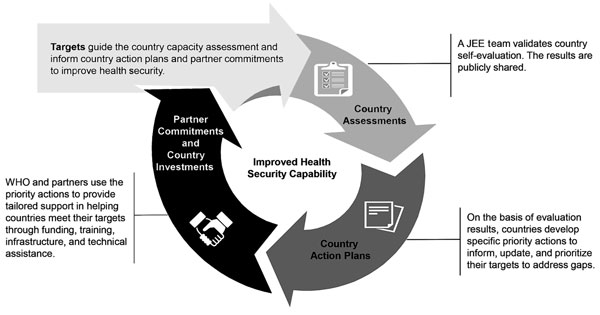Volume 23, Supplement—December 2017
SUPPLEMENT ISSUE
Global Health Security Supplement
Overview
Joint External Evaluation—Development and Scale-Up of Global Multisectoral Health Capacity Evaluation Process
Figure 2

Figure 2. JEE continuum iterative process to identify and fill gaps in addressing requirements for each indicator under 19 technical areas. Each JEE follows a standardized process that aligns with the principles of transparency, multisectoral engagement, and public reporting of the International Health Regulations 2005 (2) and the Global Health Security Agenda (https://www.ghsagenda.org/). The process to improve health security capacity requires continuous evaluation of capabilities and (re)alignment of resources. JEE, Joint External Evaluation; WHO, World Health Organization.
References
- Peiris JS, Yuen KY, Osterhaus AD, Stöhr K. The severe acute respiratory syndrome. N Engl J Med. 2003;349:2431–41. DOIPubMedGoogle Scholar
- World Health Organization. International Health Regulations (2005). 3rd ed. [cited 2017 Oct 6]. http://apps.who.int/iris/bitstream/10665/246107/1/9789241580496-eng.pdf
- Rodier G, Greenspan AL, Hughes JM, Heymann DL. Global public health security. Emerg Infect Dis. 2007;13:1447–52. DOIPubMedGoogle Scholar
- Gostin LO, Katz R. The International Health Regulations: the governing framework for global health security. Milbank Q. 2016;94:264–313. DOIPubMedGoogle Scholar
- World Health Organization. Implementation of the International Health Regulations (2005). Report of the Review Committee on Second Extensions for Establishing National Public Health Capacities and on IHR Implementation [cited 2017 Oct 6]. http://apps.who.int/gb/ebwha/pdf_files/WHA68/A68_22Add1-en.pdf
- World Health Organization. Development, monitoring and evaluation of functional core capacity for implementing the International Health Regulations (2005): concept note [cited 2017 Oct 6]. http://www.who.int/ihr/publications/concept_note_201507/en/
- Frieden TR, Tappero JW, Dowell SF, Hien NT, Guillaume FD, Aceng JR. Safer countries through global health security. Lancet. 2014;383:764–6. DOIPubMedGoogle Scholar
- World Health Organization, Regional Committee for the Eastern Mediterranean. Global health security—challenges and opportunities with special emphasis on the International Health Regulations (2005) [cited 2017 Oct 6]. http://applications.emro.who.int/docs/RC61_Resolutions_2014_R2_15554_EN.pdf?ua=1
- Vong S, Samuel R, Gould P, El Sakka H, Rana BJ, Pinyowiwat V, et al. Assessment of Ebola virus disease preparedness in the WHO South-East Asia Region. Bull World Health Organ. 2016;94:913–24. DOIPubMedGoogle Scholar
- World Health Organization. Joint External Evaluation tool: International Health Regulations (2005) [cited 2017 Oct 6]. http://www.who.int/iris/handle/10665/204368
- International Working Group on Financing Preparedness. From panic and neglect to investing in health security: financing pandemic preparedness at a national level [cited 2017 Oct 6]. http://documents.worldbank.org/curated/en/979591495652724770/text/115271-REVISED-IWG-Report-Conference-Edition-5-25-2017-1-1-optimized-low.txt
- World Health Organization. Strategic Partnership Portal. April 2017 [cited 2017 Oct 6]. https://extranet.who.int/spp/about-strategic-partnership-portal
- World Health Organization, Regional Committee for the Eastern Mediterranean. Assessment and monitoring of the implementation of the International Health Regulations (2005) EM/RC62/8, September 2015 [cited 2017 Oct 6]. http://applications.emro.who.int/docs/RC_technical_papers_2016_inf_doc_4_19016_EN.pdf
- World Health Organization. International Health Regulations (2005). IHR core capacity monitoring framework: checklist and indicators for monitoring progress in the development of IHR core capacities in states parties. April 2013 [cited 2017 Oct 6]. http://apps.who.int/iris/bitstream/10665/84933/1/WHO_HSE_GCR_2013.2_eng.pdf
- World Health Organization. Strategic Partnership Portal. IHR monitoring and evaluation framework [cited 2017 Oct 6]. https://extranet.who.int/spp/ihrmef
1Additional members who contributed data are listed at the end of this article.
Page created: November 20, 2017
Page updated: November 20, 2017
Page reviewed: November 20, 2017
The conclusions, findings, and opinions expressed by authors contributing to this journal do not necessarily reflect the official position of the U.S. Department of Health and Human Services, the Public Health Service, the Centers for Disease Control and Prevention, or the authors' affiliated institutions. Use of trade names is for identification only and does not imply endorsement by any of the groups named above.